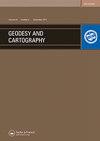研究区域垂直规划的局部地形建模方法
IF 2.1
Q3 REMOTE SENSING
引用次数: 0
摘要
本文章由计算机程序翻译,如有差异,请以英文原文为准。
The study of local terrain modeling methods for vertical planning of the territory
This work aims to study the vertical planning method for the terrain area as part of the process of construction geodetic support. Such planning will be carried out based on the aerial survey data from UAVs, which allow the creation of a high-quality digital elevation model (DEM) with sufficient node density for reliable surface terrain modelling. During the study, we test the hypothesis of the possibility of using archival aerial photographs from UAVs to model the terrain of the local area. Both the actual achievable accuracy of terrain modeling in the course of photogrammetric processing of archived aerial photographs, and methods for creating a polygonal terrain model using input spatial data in the form of clouds of 3D points of a given density require analysis. To do this, we will perform comparisons of the accuracy of calculating earth masses, carried out based on the digital triangulation elevation models (TIN). These models were based on different algorithms for creating Delaunay triangulation with different degrees of 3D point sparsity. We proposed to use sparsity of dense clouds of points representing the surface of the terrain and which were obtained by the photogrammetric method. Computer terrain modelling and calculation of vertical planning parameters were performed by us for the area with flat terrain at angles up to 3.5 degrees. We evaluated the potential of archived UAV aerial photographs and algorithms for creating Delaunay triangulation at different densities of its nodes for calculating the volumes of earth masses.
求助全文
通过发布文献求助,成功后即可免费获取论文全文。
去求助
来源期刊

Geodesy and Cartography
REMOTE SENSING-
CiteScore
1.50
自引率
0.00%
发文量
0
审稿时长
15 weeks
期刊介绍:
THE JOURNAL IS DESIGNED FOR PUBLISHING PAPERS CONCERNING THE FOLLOWING FIELDS OF RESEARCH: •study, establishment and improvement of the geodesy and mapping technologies, •establishing and improving the geodetic networks, •theoretical and practical principles of developing standards for geodetic measurements, •mathematical treatment of the geodetic and photogrammetric measurements, •controlling and application of the permanent GPS stations, •study and measurements of Earth’s figure and parameters of the gravity field, •study and development the geoid models,
 求助内容:
求助内容: 应助结果提醒方式:
应助结果提醒方式:


